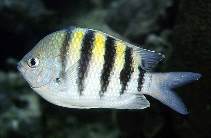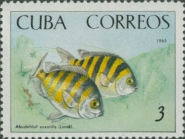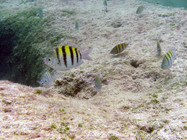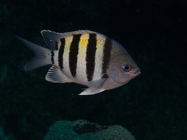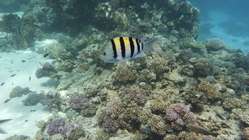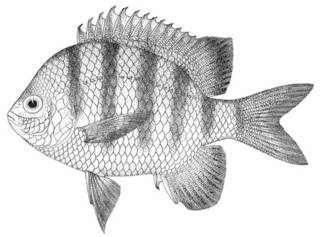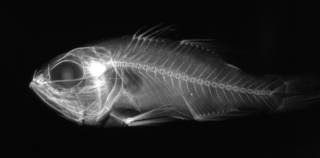WoRMS taxon details
Abudefduf saxatilis (Linnaeus, 1758)
159288 (urn:lsid:marinespecies.org:taxname:159288)
accepted
Species
Abudefduf ascensionis Fowler, 1919 · unaccepted
Abudefduf marginatus (Bloch, 1787) · unaccepted
Abudefduf saxiatilis (Linnaeus, 1758) · unaccepted (misspelling)
Abudefduf sexatilis (Linnaeus, 1758) · unaccepted (misspelling)
Apogon quinquevittatus Blyth, 1858 · unaccepted
Chaetodon marginatus Bloch, 1787 · unaccepted
Chaetodon mauritii Bloch, 1787 · unaccepted
Chaetodon sargoides Lacepède, 1802 · unaccepted
Chaetodon saxatilis Linnaeus, 1758 · unaccepted
Glyphidodon saxatilis (Linnaeus, 1758) · unaccepted
Glyphisodon biniar Montrouzier, 1857 · unaccepted
Glyphisodon moucharra Lacepède, 1802 · unaccepted
Glyphisodon saxatilis · unaccepted
marine, brackish, fresh, terrestrial
(of Chaetodon saxatilis Linnaeus, 1758) Linnaeus, C. (1758). Systema Naturae per regna tria naturae, secundum classes, ordines, genera, species, cum characteribus, differentiis, synonymis, locis. <em>Editio decima, reformata [10th revised edition], vol. 1: 824 pp. Laurentius Salvius: Holmiae.</em> , available online at https://biodiversitylibrary.org/page/726886 [details] Available for editors  [request]
[request]
Description Usually found in shallow waters to around 15 meters, juveniles are common in tide pools while adults school over shallow...
Distribution Atlantic Ocean: 40.9°N to Uruguay in the western Atlantic, abundant on Caribbean reefs; around islands of the...
Description Usually found in shallow waters to around 15 meters, juveniles are common in tide pools while adults school over shallow reeftops. Adults frequently form large feeding aggregations of up to several hundred individuals. Food items include algae, small crustaceans and fish, and various invertebrate larvae. Adult males adopt a bluish ground colour when guarding eggs. Attracted to divers who feed fish. Generally common (Ref. 9710). [details]
Distribution Atlantic Ocean: 40.9°N to Uruguay in the western Atlantic, abundant on Caribbean reefs; around islands of the...
Distribution Atlantic Ocean: 40.9°N to Uruguay in the western Atlantic, abundant on Caribbean reefs; around islands of the mid-Atlantic, Cape Verde, and along the tropical coast of western Africa south to Angola [details]
Froese, R. and D. Pauly. Editors. (2024). FishBase. Abudefduf saxatilis (Linnaeus, 1758). Accessed through: World Register of Marine Species at: https://www.marinespecies.org/aphia.php?p=taxdetails&id=159288 on 2024-04-18
![]() The webpage text is licensed under a Creative Commons Attribution-Noncommercial 4.0 License
The webpage text is licensed under a Creative Commons Attribution-Noncommercial 4.0 License
original description
(of Apogon quinquevittatus Blyth, 1858) Blyth, E. (1858). Report of Curator, Zoological Department, for May, 1858. <em>Journal of the Asiatic Society of Bengal.</em> 27(3): 267-290.
page(s): 272 [details]
original description (of Chaetodon marginatus Bloch, 1787) Bloch, M. E. (1787). Naturgeschichte der ausländischen Fische. <em>Berlin.</em> v. 3: i-xii + 1-146. Pls. 181-216.
page(s): 98, Pl. 207 [details]
original description (of Chaetodon mauritii Bloch, 1787) Bloch, M. E. (1787). Naturgeschichte der ausländischen Fische. <em>Berlin.</em> v. 3: i-xii + 1-146. Pls. 181-216.
page(s): 109, Pl. 213 (fig. 1) [details]
original description (of Chaetodon sargoides Lacepède, 1802) Lacepède, B.G.E. (1802). Histoire naturelle des poissons: IV. <em>chez Plassan: Paris, France.</em> v. 4: i-xliv + 1-728, Pl. 1-16., available online at https://www.biodiversitylibrary.org/page/6705733
page(s): 453, 471, Pl. 10 (fig. 3) [details]
original description (of Chaetodon saxatilis Linnaeus, 1758) Linnaeus, C. (1758). Systema Naturae per regna tria naturae, secundum classes, ordines, genera, species, cum characteribus, differentiis, synonymis, locis. <em>Editio decima, reformata [10th revised edition], vol. 1: 824 pp. Laurentius Salvius: Holmiae.</em> , available online at https://biodiversitylibrary.org/page/726886 [details] Available for editors [request]
[request]
original description (of Glyphisodon moucharra Lacepède, 1802) Lacepède, B.G.E. (1802). Histoire naturelle des poissons: IV. <em>chez Plassan: Paris, France.</em> v. 4: i-xliv + 1-728, Pl. 1-16., available online at https://www.biodiversitylibrary.org/page/6705733
page(s): 542, 543 [details]
context source (Bermuda) Smith-Vaniz, W. F.; Collette, B. B.; Luckhurst, B. E (1999). Fishes of Bermuda: History, zoogeography, annotated checklist, and identification keys (American Society of Ichthyologists and Herpetologists - Special Publication No.4) . ASIH, 424 pp. [details]
basis of record Smith, J. L. B. (1960). Coral Fishes of the Family Pomacentridae from the Western Indian Ocean and the Red Sea. <em>Ichthyological Bulletin No.</em> 19: 317-349. [details] Available for editors [request]
[request]
additional source McEachran, J. D. (2009). Fishes (Vertebrata: Pisces) of the Gulf of Mexico, Pp. 1223–1316 in: Felder, D.L. and D.K. Camp (eds.), Gulf of Mexico–Origins, Waters, and Biota. Biodiversity. Texas A&M Press, College Station, Texas. [details]
additional source Froese, R. & D. Pauly (Editors). (2023). FishBase. World Wide Web electronic publication. version (02/2023)., available online at https://www.fishbase.org [details]
additional source Gulf of Maine Biogeographic Information System (GMBIS) Electronic Atlas. 2002. November, 2002. [details]
ecology source Looby, A.; Erbe, C.; Bravo, S.; Cox, K.; Davies, H. L.; Di Iorio, L.; Jézéquel, Y.; Juanes, F.; Martin, C. W.; Mooney, T. A.; Radford, C.; Reynolds, L. K.; Rice, A. N.; Riera, A.; Rountree, R.; Spriel, B.; Stanley, J.; Vela, S.; Parsons, M. J. G. (2023). Global inventory of species categorized by known underwater sonifery. <em>Scientific Data.</em> 10(1). (look up in IMIS), available online at https://doi.org/10.1038/s41597-023-02745-4 [details]
page(s): 272 [details]
original description (of Chaetodon marginatus Bloch, 1787) Bloch, M. E. (1787). Naturgeschichte der ausländischen Fische. <em>Berlin.</em> v. 3: i-xii + 1-146. Pls. 181-216.
page(s): 98, Pl. 207 [details]
original description (of Chaetodon mauritii Bloch, 1787) Bloch, M. E. (1787). Naturgeschichte der ausländischen Fische. <em>Berlin.</em> v. 3: i-xii + 1-146. Pls. 181-216.
page(s): 109, Pl. 213 (fig. 1) [details]
original description (of Chaetodon sargoides Lacepède, 1802) Lacepède, B.G.E. (1802). Histoire naturelle des poissons: IV. <em>chez Plassan: Paris, France.</em> v. 4: i-xliv + 1-728, Pl. 1-16., available online at https://www.biodiversitylibrary.org/page/6705733
page(s): 453, 471, Pl. 10 (fig. 3) [details]
original description (of Chaetodon saxatilis Linnaeus, 1758) Linnaeus, C. (1758). Systema Naturae per regna tria naturae, secundum classes, ordines, genera, species, cum characteribus, differentiis, synonymis, locis. <em>Editio decima, reformata [10th revised edition], vol. 1: 824 pp. Laurentius Salvius: Holmiae.</em> , available online at https://biodiversitylibrary.org/page/726886 [details] Available for editors
original description (of Glyphisodon moucharra Lacepède, 1802) Lacepède, B.G.E. (1802). Histoire naturelle des poissons: IV. <em>chez Plassan: Paris, France.</em> v. 4: i-xliv + 1-728, Pl. 1-16., available online at https://www.biodiversitylibrary.org/page/6705733
page(s): 542, 543 [details]
context source (Bermuda) Smith-Vaniz, W. F.; Collette, B. B.; Luckhurst, B. E (1999). Fishes of Bermuda: History, zoogeography, annotated checklist, and identification keys (American Society of Ichthyologists and Herpetologists - Special Publication No.4) . ASIH, 424 pp. [details]
basis of record Smith, J. L. B. (1960). Coral Fishes of the Family Pomacentridae from the Western Indian Ocean and the Red Sea. <em>Ichthyological Bulletin No.</em> 19: 317-349. [details] Available for editors
additional source McEachran, J. D. (2009). Fishes (Vertebrata: Pisces) of the Gulf of Mexico, Pp. 1223–1316 in: Felder, D.L. and D.K. Camp (eds.), Gulf of Mexico–Origins, Waters, and Biota. Biodiversity. Texas A&M Press, College Station, Texas. [details]
additional source Froese, R. & D. Pauly (Editors). (2023). FishBase. World Wide Web electronic publication. version (02/2023)., available online at https://www.fishbase.org [details]
additional source Gulf of Maine Biogeographic Information System (GMBIS) Electronic Atlas. 2002. November, 2002. [details]
ecology source Looby, A.; Erbe, C.; Bravo, S.; Cox, K.; Davies, H. L.; Di Iorio, L.; Jézéquel, Y.; Juanes, F.; Martin, C. W.; Mooney, T. A.; Radford, C.; Reynolds, L. K.; Rice, A. N.; Riera, A.; Rountree, R.; Spriel, B.; Stanley, J.; Vela, S.; Parsons, M. J. G. (2023). Global inventory of species categorized by known underwater sonifery. <em>Scientific Data.</em> 10(1). (look up in IMIS), available online at https://doi.org/10.1038/s41597-023-02745-4 [details]
 Present
Present  Present in aphia/obis/gbif/idigbio
Present in aphia/obis/gbif/idigbio  Inaccurate
Inaccurate  Introduced: alien
Introduced: alien  Containing type locality
Containing type locality
From other sources
Description Usually found in shallow waters to around 15 meters, juveniles are common in tide pools while adults school over shallow reeftops. Adults frequently form large feeding aggregations of up to several hundred individuals. Food items include algae, small crustaceans and fish, and various invertebrate larvae. Adult males adopt a bluish ground colour when guarding eggs. Attracted to divers who feed fish. Generally common (Ref. 9710). [details]Diet Food items include algae, small crustaceans and fish, and various invertebrate larvae [details]
Distribution Atlantic Ocean: 40.9°N to Uruguay in the western Atlantic, abundant on Caribbean reefs; around islands of the mid-Atlantic, Cape Verde, and along the tropical coast of western Africa south to Angola [details]
Habitat Adults frequently form large feeding aggregations of up to several hundred individuals. [details]
Habitat nektonic [details]
Importance Social- Commercial, aquariumfish [details]
Remark Slight differenced from the Atlantic to the Indo-Pacific have led some authors to regard the Indo-Pacific form as a distinct species, A. vaigiensis (Quoy & Gaimard) Randall (1992). [details]
To Barcode of Life (134 barcodes)
To Biodiversity Heritage Library (1 publication) (from synonym Abudefduf ascensionis Fowler, 1919)
To Biodiversity Heritage Library (107 publications)
To Biodiversity Heritage Library (12 publications) (from synonym Glyphisodon moucharra Lacepède, 1802)
To Biodiversity Heritage Library (15 publications) (from synonym Chaetodon marginatus Bloch, 1787)
To Biodiversity Heritage Library (19 publications) (from synonym Abudefduf marginatus (Bloch, 1787))
To Biodiversity Heritage Library (2 publications) (from synonym Chaetodon mauritii Bloch, 1787)
To Biodiversity Heritage Library (2 publications) (from synonym Abudefduf sexatilis (Linnaeus, 1758))
To Biodiversity Heritage Library (3 publications) (from synonym Glyphisodon biniar Montrouzier, 1857)
To Biodiversity Heritage Library (35 publications) (from synonym Chaetodon saxatilis Linnaeus, 1758)
To Biodiversity Heritage Library (52 publications) (from synonym Glyphidodon saxatilis (Linnaeus, 1758))
To Biodiversity Heritage Library (6 publications) (from synonym Apogon quinquevittatus Blyth, 1858)
To Biodiversity Heritage Library (65 publications) (from synonym Glyphisodon saxatilis)
To Biodiversity Heritage Library (7 publications) (from synonym Chaetodon sargoides Lacepède, 1802)
To Digital Atlas Of Marine Species & Locations, DAMSL (Sergeant major)
To European Nucleotide Archive (ENA)
To FishBase
To FishBase (from synonym Apogon quinquevittatus Blyth, 1858)
To FishBase (from synonym Chaetodon marginatus Bloch, 1787)
To FishBase (from synonym Chaetodon mauritii Bloch, 1787)
To FishBase (from synonym Chaetodon saxatilis Linnaeus, 1758)
To FishBase (from synonym Chaetodon sargoides Lacepède, 1802)
To FishBase (from synonym Glyphidodon saxatilis (Linnaeus, 1758))
To FishBase (from synonym Abudefduf ascensionis Fowler, 1919)
To FishBase (from synonym Glyphisodon moucharra Lacepède, 1802)
To FishBase (from synonym Abudefduf saxiatilis (Linnaeus, 1758))
To FishBase (from synonym Abudefduf sexatilis (Linnaeus, 1758))
To FishBase (from synonym Glyphisodon biniar Montrouzier, 1857)
To FishBase (from synonym Abudefduf marginatus (Bloch, 1787))
To FishBase images (Abudefduf saxatilis, Neth Antilles, by Patzner, R.)
To GenBank (414 nucleotides; 216 proteins)
To GenBank (414 nucleotides; 216 proteins) (from synonym Chaetodon saxatilis Linnaeus, 1758)
To Global Biotic Interactions (GloBI)
To IUCN Red List (Least Concern)
To NMNH Extant Collection (Abudefduf ascensionis P00014 illustration) (from synonym Abudefduf ascensionis Fowler, 1919)
To NMNH Extant Collection (Apogon alutus USNM 275068 radiograph lateral view)
To NMNH Extant Collection (Gliphidodon saxatilis P11394 illustration)
To ITIS
To Biodiversity Heritage Library (1 publication) (from synonym Abudefduf ascensionis Fowler, 1919)
To Biodiversity Heritage Library (107 publications)
To Biodiversity Heritage Library (12 publications) (from synonym Glyphisodon moucharra Lacepède, 1802)
To Biodiversity Heritage Library (15 publications) (from synonym Chaetodon marginatus Bloch, 1787)
To Biodiversity Heritage Library (19 publications) (from synonym Abudefduf marginatus (Bloch, 1787))
To Biodiversity Heritage Library (2 publications) (from synonym Chaetodon mauritii Bloch, 1787)
To Biodiversity Heritage Library (2 publications) (from synonym Abudefduf sexatilis (Linnaeus, 1758))
To Biodiversity Heritage Library (3 publications) (from synonym Glyphisodon biniar Montrouzier, 1857)
To Biodiversity Heritage Library (35 publications) (from synonym Chaetodon saxatilis Linnaeus, 1758)
To Biodiversity Heritage Library (52 publications) (from synonym Glyphidodon saxatilis (Linnaeus, 1758))
To Biodiversity Heritage Library (6 publications) (from synonym Apogon quinquevittatus Blyth, 1858)
To Biodiversity Heritage Library (65 publications) (from synonym Glyphisodon saxatilis)
To Biodiversity Heritage Library (7 publications) (from synonym Chaetodon sargoides Lacepède, 1802)
To Digital Atlas Of Marine Species & Locations, DAMSL (Sergeant major)
To European Nucleotide Archive (ENA)
To FishBase
To FishBase (from synonym Apogon quinquevittatus Blyth, 1858)
To FishBase (from synonym Chaetodon marginatus Bloch, 1787)
To FishBase (from synonym Chaetodon mauritii Bloch, 1787)
To FishBase (from synonym Chaetodon saxatilis Linnaeus, 1758)
To FishBase (from synonym Chaetodon sargoides Lacepède, 1802)
To FishBase (from synonym Glyphidodon saxatilis (Linnaeus, 1758))
To FishBase (from synonym Abudefduf ascensionis Fowler, 1919)
To FishBase (from synonym Glyphisodon moucharra Lacepède, 1802)
To FishBase (from synonym Abudefduf saxiatilis (Linnaeus, 1758))
To FishBase (from synonym Abudefduf sexatilis (Linnaeus, 1758))
To FishBase (from synonym Glyphisodon biniar Montrouzier, 1857)
To FishBase (from synonym Abudefduf marginatus (Bloch, 1787))
To FishBase images (Abudefduf saxatilis, Neth Antilles, by Patzner, R.)
To GenBank (414 nucleotides; 216 proteins)
To GenBank (414 nucleotides; 216 proteins) (from synonym Chaetodon saxatilis Linnaeus, 1758)
To Global Biotic Interactions (GloBI)
To IUCN Red List (Least Concern)
To NMNH Extant Collection (Abudefduf ascensionis P00014 illustration) (from synonym Abudefduf ascensionis Fowler, 1919)
To NMNH Extant Collection (Apogon alutus USNM 275068 radiograph lateral view)
To NMNH Extant Collection (Gliphidodon saxatilis P11394 illustration)
To ITIS
From editor or global species database
From other sources
